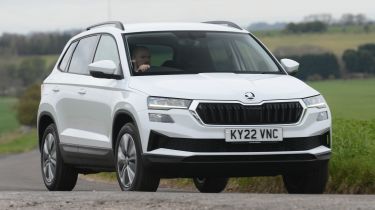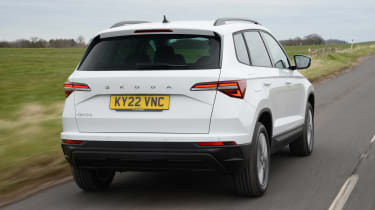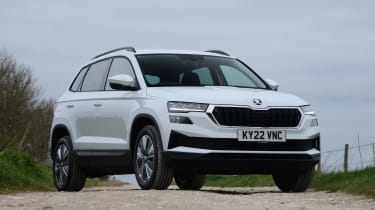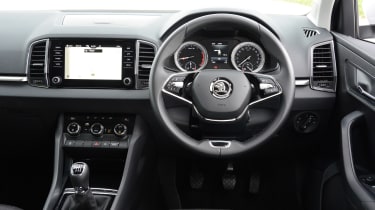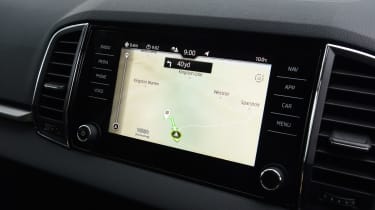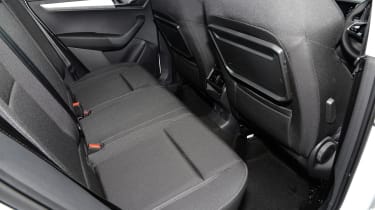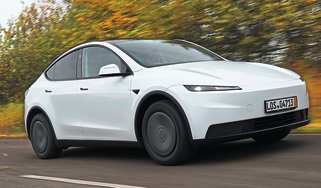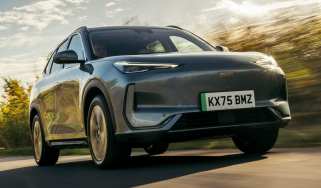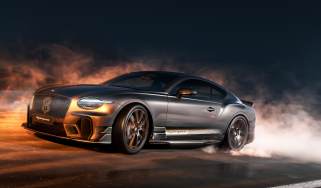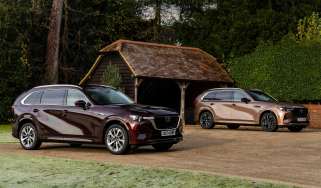Skoda Karoq review
The Skoda Karoq provides plenty of practicality as well as all the equipment you could realistically need

Our opinion on the Skoda Karoq
In a crowded mid-size SUV marketplace, the Skoda Karoq offers what matters most for family car buyers: useful practicality, decent comfort and good levels of standard kit all wrapped up in a competitively priced package. It might be a little plain looking, but it offers a smart and sophisticated image that sits well with its pragmatic ability to soak up the rigours of day-to-day life.
You won't find a hybrid model in the lineup, which may deter some, but the Karoq still provides decent fuel economy from its petrol and diesel engine range. The Karoq also has a number of well-thought-out details that should go down well with the target family car buyer.
About the Skoda Karoq
The Karoq's design has a lot in common with the SEAT Ateca, with the two cars sharing the same platform, engines, and technology. However, the Ateca is just one of a number of strong contenders in the mid-size SUV class.
A minor facelift back in 2022 introduced a wider, more upright grille, redesigned bumpers, and light clusters. Skoda has also added smoother underbody cladding, an extended rear spoiler, and aero covers for the alloy wheels to help improve aerodynamic efficiency. Another mild update in 2024 saw several of the Karoq’s engines receive a power boost.
Used - available now

2022 Skoda
Karoq
28,479 milesManualPetrol1.5L
Cash £16,989
2025 Skoda
Karoq
27,775 milesAutomaticPetrol1.5L
Cash £19,784
2025 Skoda
Karoq
12,765 milesAutomaticPetrol1.5L
Cash £21,545
2022 Skoda
Karoq
27,429 milesAutomaticPetrol2.0L
Cash £22,613One thing the Karoq lacks is a more eco-focused hybrid model, but if you’re looking for something electrified, the Czech firm will steer you towards the impressive Skoda Elroq and Skoda Enyaq instead.
We’ve tested several variations of the Skoda Karoq since its initial UK launch. This Skoda has managed to defeat the Volkswagen T-Roc, Vauxhall Grandland and even the highly popular Nissan Qashqai in our group tests over the years. We also spent six months with a Skoda Karoq in SE L trim to determine exactly what this family SUV is like to live with.
Skoda Karoq prices and latest deals
The entry-level Skoda Karoq SE Edition kicks off the line-up from around £31,000. In the middle of the range sits the SE L Edition, which ups the price to at least £33,100, while the range-topping Sportline Edition will set you back at least £37,300.
If you’re tempted by the Karoq and would like to save an average of £3,000, you can build your perfect Skoda Karoq through the Auto Express Buy a Car service. We also have a number of new Karoqs in stock, as well as some very tempting used Skoda Karoq deals. We can also assist you with selling your car.
Performance & driving experience
Pros |
|
Cons |
|
Under the skin, the Skoda Karoq uses a tried-and-tested recipe, combining the VW Group’s MQB underpinnings (with MacPherson strut front suspension and a torsion beam rear axle on 2WD versions, while 4x4 cars have a multilink set-up) that also forms the basis of the Skoda Kodiaq and many other models in the Czech brand’s line-up, highlighting its versatility.
| Model | Power | 0-62mph | Top speed |
| Karoq 1.5 TSI SE L Edition | 150bhp | 8.9 seconds | 130mph |
| Karoq 2.0 TSI Sportline Edition 4x4 | 190bhp | 7 seconds | 137mph |
| Karoq 2.0 TDI SE L Edition 4x4 | 150bhp | 8.7 seconds | 126mph |
Performance, 0-60mph acceleration and top speed
Of the three petrol engines, the mid-range 1.5 TSI comes out as our clear favourite, although the smaller 1.0-litre three-cylinder engine performs pretty well, too. The entry-level TSI unit makes a respectable 114bhp, and while it will accelerate the Karoq from 0-62mph in 10.3 seconds, it’ll feel a little strained at higher speeds when fully laden. If you work it hard, the engine - which delivers a not unpleasant three-cylinder thrum - does cause a small amount of vibration through the pedals.
The 148bhp 1.5 TSI has a broader power band, making it a stronger performer. It’ll get from 0 to 62mph in 8.9 seconds (or 9.0 seconds with the DSG twin-clutch auto option), and you don’t have to work the engine quite so hard to get up to motorway speeds.
The 2.0-litre TSI petrol is available in Sportline Edition trim with the seven-speed DSG dual-clutch gearbox and all-wheel drive. Its 187bhp output makes the Karoq decidedly lively, and it can accelerate from 0 to 62 mph in 7.0 seconds.
The 2.0-litre TDI has 148bhp, and knocks off the benchmark sprint in 8.7 seconds, as well as offering enough punch for overtaking. This will help if you intend to tow a caravan with your Karoq, as will the fact that this engine can also be accompanied by all-wheel drive.
Town driving, visibility and parking
The Skoda Karoq is a pleasingly easy car to drive, and it shouldn’t prove challenging in urban streets, even though it is a fairly large model. All-round visibility is decent enough, although not quite as good as in the Nissan Qashqai, and the controls are light enough to prevent any aches when stuck in stop-start traffic.
Parking the Karoq is pretty straightforward, too, thanks to a reversing camera being standard across the entire line-up.
Country road driving and handling
On the move, the Skoda feels sharper than the Peugeot 3008. The steering is nicely weighted and more responsive, helping the car feel more agile, with less roll when changing direction. This stems from the Karoq’s firmer suspension, but the downside is that you’ll feel more body and wheel movements than in the 3008, which smooths out poor surfaces nicely. The Karoq isn't as firm as its SEAT Ateca sister model, and our group test showed that it rides better overall than the Vauxhall Grandland and Nissan Qashqai.
The faster you go, the more the Karoq’s fine body control comes to the fore, giving plenty of security and confidence. The slick-shifting manual gearbox is fun to use, and the well-shaped steering wheel feels good in your hands.
The more energy you put through the springs and dampers, the more the ride quality calms down, but because SUVs are likely to spend lots of time in town, the firmness from the Skoda’s suspension over broken surfaces just takes the edge off the car’s otherwise impressive refinement score.
The Sportline Edition model comes with 19-inch alloy wheels, which we feel unduly affects the Karoq's ride. These wheels cause a fairly compliant mid-size SUV to develop unwelcome jiggliness over uneven A and B roads.
Motorway driving and long-distance comfort
When fitted with the 19-inch wheels, we found the Karoq suffered from some annoying harmonics when driven over concrete sections of motorway. We recommend models with smaller wheels (our preferred SE L Edition has 18-inch items) because you’ll have a much more compliant ride.
The Karoq is marred by a little wind noise around the windscreen pillars and door mirrors at higher speeds.
”The six-speed manual gearbox has a really slick shift action, which actually makes the Skoda surprisingly good to drive. It’s helped by the supple and controlled ride, which translates to good body control when cornering, meaning the extra height of the SUV bodystyle isn’t really felt.” - Steve Walker, head of digital content.
MPG & running costs
Pros |
|
Cons |
|
The Karoq’s smaller petrol engines look attractive from a cost point of view, because they’re pretty efficient and cheaper to buy than the diesels.
The Karoq’s engines aren’t class-leading for economy, but they’re still competitive in the sector. The 1.0 TSI can return up to 48.8mpg on the WLTP combined cycle, while emitting 132g/km of CO2.
The larger 1.5 TSI’s official maximum combined cycle figures are 47.6mpg (46.8mpg with the DSG auto), with CO2 emissions from 135g/km. Our tests of this 1.5-litre unit suggest that owners should be able to get very close to those numbers in the real world, thanks to fuel-saving cylinder deactivation tech that’s fitted to this engine. This system shuts down two of its four cylinders when cruising at a constant speed.
If you really want to get the most mileage out of every gallon, the two-wheel drive 2.0-litre TDI claims 49.3mpg, although its emissions aren’t so good at 150g/km. The thirstiest Karoq is the petrol-powered 4x4, which only manages 36.9mpg and puts out a whopping 174g/km of CO2.
| Model | MPG | CO2 | Insurance group |
| Karoq 1.5 TSI SE L Edition | 46.9mpg | 127g/km | 19 |
| Karoq 2.0 TSI Sportline Edition 4x4 | 36.9mpg | 150g/km | 26 |
| Karoq 2.0 TDI SE L Edition 4x4 | 48.7mpg | 127g/km | 20 |
Insurance groups
You won’t pay too much for insurance with any of the Karoq models, but the lower spec versions are obviously cheaper. The smallest 1.0-litre petrol engine in SE Drive trim resides in group 12, but opting for the more powerful 2.0-litre diesel only ups the insurance rating to groups 20-21. Predictably, the 187bhp 2.0-litre TSI petrol in range-topping Sportline Edition trim is the costliest Karoq to insure because this sits in group 26.
The Nissan Qashqai is similar to the Skoda in terms of insurance, as this car resides between groups 11 and 26.
Tax
With no hybrid or electric Karoq variants to be found, there are no emissions-based tax breaks to be found here for company car drivers. As well as being liable for the standard rate of VED road tax, opting for higher trim levels, larger engines and ticking off the options list can quickly pull this mid-size SUV over the £40,000 mark. If you do this, you’ll incur the £620 annual luxury car tax levy.
Drivers hoping for low Benefit-in-Kind (BiK) company car tax rates will be better off looking towards the fully electric Skoda Elroq or Enyaq.
Depreciation
Skoda has a pretty good reputation for strong residual values, and our latest expert data suggests that the Karoq should retain between 46 to 48 per cent of its initial value over three years and 36,000 miles, depending on your chosen engine and trim level. The Nissan Qashqai performs similarly, holding on to between 44 and 49 per cent of its value over the same period.
To get an accurate valuation on a specific model check out our free car valuation tool...
Interior, design & technology
Pros |
|
Cons |
|
Some may see the design of the Skoda Karoq as being less characterful than its Yeti predecessor, but while it lacks the stylistic flair of the Toyota C-HR, the Karoq does have a solid, almost premium appeal.
At a glance, the Karoq shares a strong resemblance with the bigger seven-seat Skoda Kodiaq (and, indeed, the smaller Skoda Kamiq), with a very similar grille and headlamp design, a ridge up the centre of the bonnet, and chunky wheel arches.
The biggest differences are the rear lights and the extra length, width, and height of the Kodiaq if you park them side-by-side. Both are only available in a five-door body style, but the Karoq only offers seating for five as opposed to the Kodiaq’s seven. However, the Karoq can be specified with a VarioFlex adjustable sliding rear bench, which allows you to alter the amount of passenger legroom or boot space depending on your needs.
Materials and build quality
As is often the case with Skodas, what the Karoq lacks in design excitement it more than makes up for with sturdy build quality. We particularly like the microsuede seats, as these add an element of luxury to this family SUV.
Infotainment, sat-nav and stereo
Built-in sat-nav isn’t as big a deal as it used to be, especially since all Karoq models get wireless Apple CarPlay and Android Auto smartphone connectivity, which allows you to run a navigation app from your phone on the standard 8.0-inch Amundsen infotainment system. Wireless phone charging is also provided as standard for this reason.
The top-of-the-range Sportline Edition version comes with a slightly larger 8.25-inch screen, although we prefer the smaller set-up used on SE Edition and SE L Edition because it retains physical dials for volume and seek functions. The optional 9.2-inch Columbus system available from SE L Edition and above adds gesture control, allowing you to control a limited number of functions with hand gestures in a similar fashion to the infotainment systems in some BMWs.
All versions provide a bright screen with sharp graphics and a simple-to-navigate menu layout, and they are more responsive than the infotainment system found in the Nissan Qashqai. Like the Qashqai, the Karoq comes with a fully digital driver’s instrument cluster, but the 10.25-inch display in the Karoq is much more configurable and easier to control using the buttons on its steering wheel.
“The interior is incredibly similar to the pre-facelift model’s, but that’s not a bad thing because it’s a very pleasant place to sit. The materials are fine – about on par with its rivals here – but it’s the clean, easy-to-use layout that we love.” - Alex Ingram, chief reviewer.
Boot space & practicality
Pros |
|
Cons |
|
The Skoda Karoq has supportive seats, a roomy cabin, and a well-designed dashboard made with high-quality materials. All things considered, it’s an impressive effort.
The large interior and voluminous boot are well suited to family use, and there are plenty of well-thought-out details that make life a little easier, such as the little bins for the front doors, standard nets in the boot, a sunglasses holder, and an umbrella hidden in the driver’s door, so you’re always prepared despite our unpredictable weather.
Dimensions & size
The Karoq is noticeably bigger than its predecessor, the Yeti, and measures 4,398mm long, 1,841mm wide and 1,612mm tall. That compares with the 4,542mm length of the Peugeot 3008, or 4,425mm of the Nissan Qashqai, so it’s pretty much on par with its rivals.
| Dimensions comparison | |||
| Model | Skoda Karoq | Nissan Qashqai | Peugeot 3008 |
| Length | 4,398mm | 4,425mm | 4,542mm |
| Width | 1,841mm | 1,835mm | 1,895mm |
| Height | 1,612mm | 1,625mm | 1,641mm |
| Wheelbase | 2,640mm | 2,670mm | 2,740mm |
| Boot space | 588 to 1,630 litres | 504 to 1,598 litres | 588 to 1,663 litres |
Seats & passenger space
There’s good leg and headroom in any of the seats in the Skoda Karoq. Taller rear seat passengers may find their knees brushing on the seat backs even with the optional VarioFlex rear bench pushed as far back as it will go, but rear legroom is generally very good for the class.
The SE Edition and SE L Edition versions of Karoq come with two Isofix points on the outer positions of the rear bench, while Sportline Edition trim adds an additional point on the front passenger seat.
Boot Space
The Karoq has an impressive 588-litre boot, and this is an exact match with the Peugeot 3008. With the rear seats in place, the Skoda manages up to 1,630 litres, which is three litres short of its French rival. Adding four-wheel drive drops the Skoda’s capacity to 500 litres and 1,609 litres, respectively, because the boot floor has to be raised to accommodate the four-wheel drive system, reducing the overall amount of space.
We’d recommend springing for the optional VarioFlex rear seats if you can. This gives you sliding and reclining rear seats that are separated out into three individual chairs, making the Karoq much more flexible when having to carry both longer items and people at the same time.
SE L and Sportline Edition variants get a tailgate that raises electrically, and there’s a ‘virtual’ boot release that allows you to open it with the waggle of a foot under the rear bumper if your hands are full.
Towing
The smallest 1.0-litre petrol can tow a decent 1,400kg braked trailer or caravan. This jumps to 1,700kg with the 1.5-litre, and 1,900kg with the 2.0-litre petrol with four-wheel drive.
If you really want the maximum towing capacity, then look toward the 2.0-litre diesel. This powertrain can tow a whopping 2,100kg, making this one of the very best performers in the mid-size SUV class.
“The Skoda’s taller SUV shape has its own practical advantages when compared with family hatchbacks. Getting kids strapped into their seats is less of a strain and many people will prefer the higher driving position.” - Steve Walker, head of digital content.
Reliability & safety
Pros |
|
Cons |
|
The Skoda Karoq hasn’t appeared in our Driver Power survey for a few years, but when this mid-size SUV was last seen in the best cars to own list, it only managed 40th place out of 75 cars. The Skoda brand isn’t exactly making waves with a 12th place finish out of 31 brands in the best manufacturer league, either.
Safety experts Euro NCAP awarded the Karoq the maximum five-star score back in 2017, but this rating has since expired due to the testing criteria having become more stringent over the years. That’s not to say that the Karoq wouldn’t still protect you well in a collision, but there are newer rivals, such as the Toyota C-HR, that could protect you even better with all the latest safety technology.
Every Karoq comes with lane-keep assistance, a driver attention monitor, autonomous emergency braking (AEB), and traffic sign recognition.
| Euro NCAP safety ratings | |
| Euro NCAP safety rating | Five stars (Euro NCAP, 2017 - expired) |
| Adult occupant protection | 93% |
| Child occupant protection | 79% |
| Vulnerable road user protection | 73% |
| Safety assist | 58% |
Buying and owning
- Best buy: Skoda Karoq 1.5 TSI SE L Edition
Aim for the middle of the range SE L Edition trim, and the Karoq comes with enough kit to keep this older mid-size SUV competitive with its rivals. Touches such as a powered tailgate and the larger 9.2-inch touchscreen increase its practicality and premium credentials, too. While the 1.0-litre petrol engine isn’t bad, we’d upgrade to the 1.5 for the increased power boost, and has a negligible effect on efficiency.
Skoda Karoq alternatives
Simply put, the mid-size SUV market is enormous, so the Skoda Karoq has its work cut out. As well as VW Group stablemates like the Volkswagen T-Roc and SEAT Ateca, there’s also the Nissan Qashqai, Kia Sportage, Hyundai Tucson and Ford Kuga to consider.
That’s already a fierce level of competition, and that’s before we even take the electric SUVs into account. Cars like the Renault Scenic, Tesla Model Y and Ford Explorer all offer strong battery range and family-friendly practicality. And, if that’s still not enough, there are also two of Skoda’s own models to consider: the Enyaq and Elroq. Just to pile on even more pressure, the Elroq is our reigning Car of the Year.
Frequently Asked Questions
The Skoda Karoq offers everything you need from a family car, including space, practicality, build quality and affordability.
Did you know you can sell your car with Auto Express? Get the highest bid from our network of over 5,500 dealers and we'll do the rest. Click here to try Auto Express Sell My Car now...
